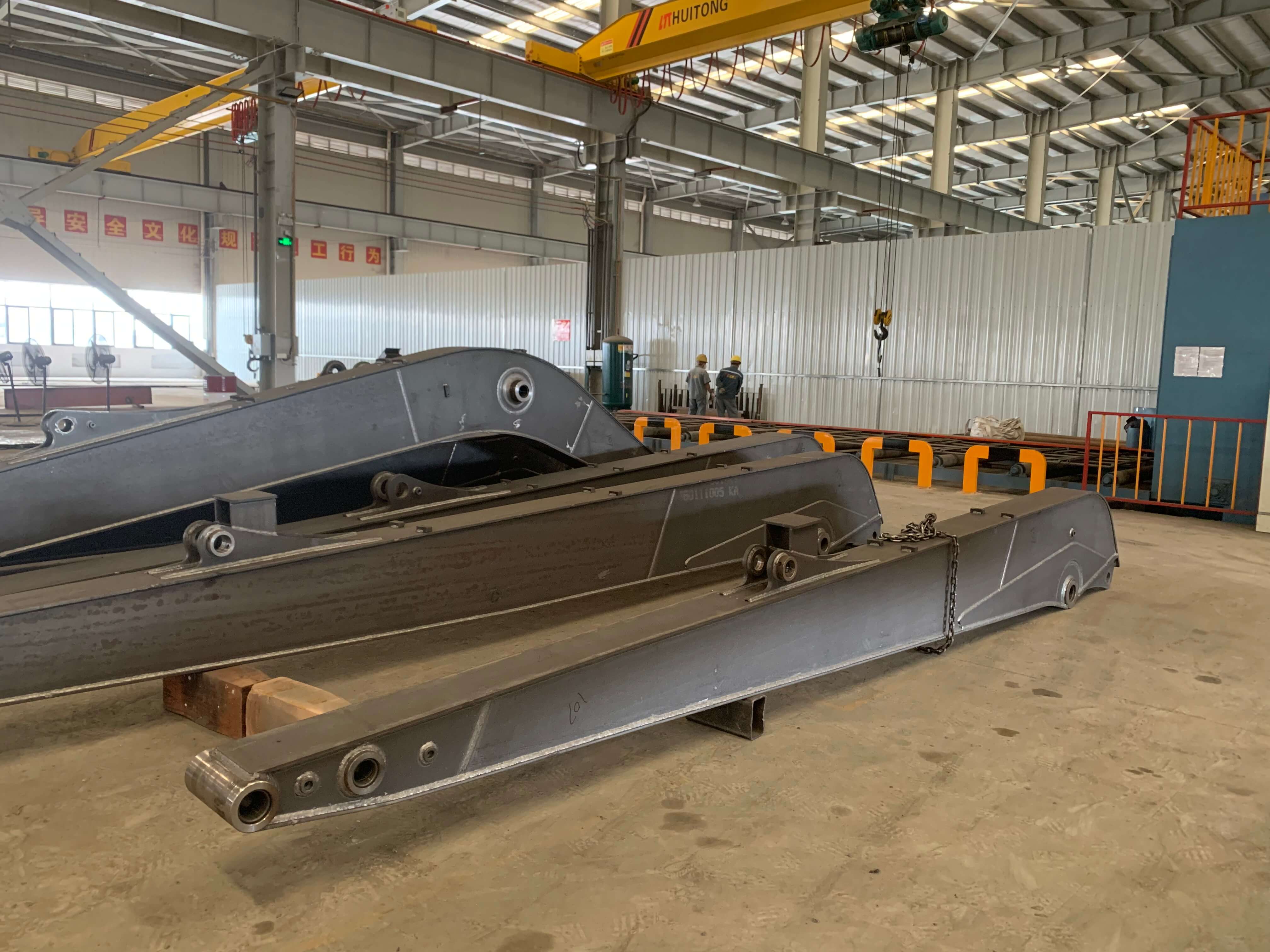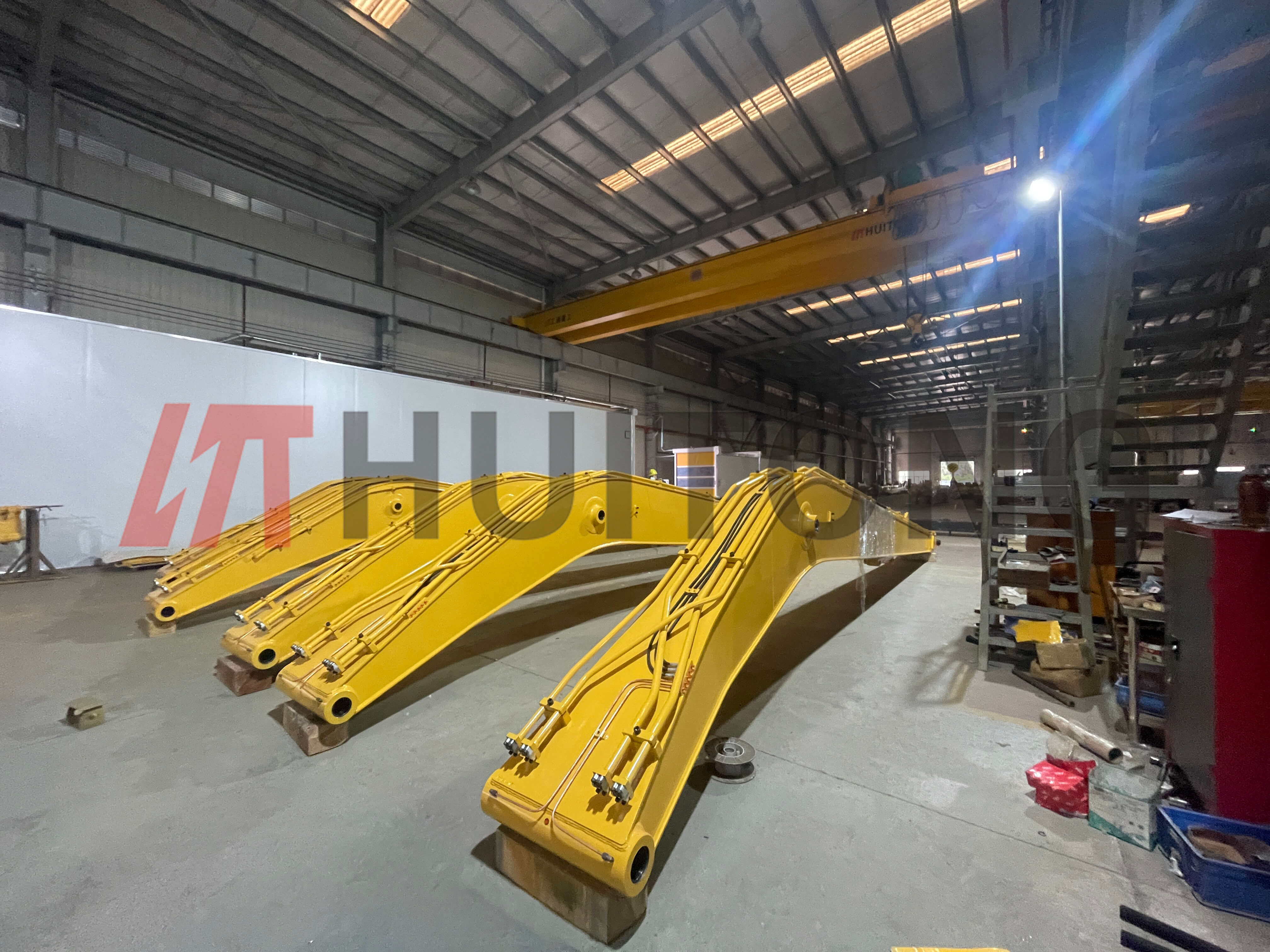 HuiTong
HuiTong  2025-06-13
2025-06-13
Recently, we have found that some customers often ask us how thick the plate is for our excavator long arms, or ask why the plate we use is thinner than others, so today we will discuss this issue with you.

In the design and manufacturing of excavator long arms, the decision regarding plate thickness (thick plates vs. thin plates) needs to consider multiple factors. The differences between them are not only reflected in weight and strength but also have a profound impact on mechanical performance, cost, manufacturing processes, and maintenance. The following is a detailed comparative analysis based on 10 key dimensions:
Bending Stiffness: Thick plates have higher stiffness (stiffness is proportional to the cube of thickness), whereas thin plates have lower stiffness, requiring box structures or reinforcements to compensate.
Impact Resistance: Thick plates offer superior resistance, suitable for heavy-duty environments such as hard rock and mining, while thin plates are more prone to deformation, requiring limited impact loads.
Fatigue Life: Over-thick plates may cause local stress concentration, reducing life, whereas thin plates, when designed properly, can optimize stress distribution and extend lifespan.
Conclusion: Thick plates are more suitable for extreme heavy-duty conditions, but care should be taken not to increase thickness blindly. Thin plates rely on structural optimization for lightweight and high strength.
Self-Weight: Thick plates increase weight by 20%-40%, reducing equipment mobility. Thin plates' lightweight design enhances rotation speed and work efficiency.
Hydraulic System Energy Consumption: Using a thick plate arm requires larger hydraulic cylinder force, increasing energy consumption. Thin plate arms reduce hydraulic load, saving 10%-15% energy.
Transportation Costs: Overweight arms with thick plates may incur higher logistics costs, while thin plate arms are easier to transport within road weight limits.
Conclusion: Thin plates have significant advantages in dynamic operation scenarios (such as frequent rotation and walking).
Direct Costs: Using thick plates increases steel consumption, raising costs by 30%-50%. Thin plates have lower material costs, making them suitable for mass production.
Processing Costs: Cutting, bending, and welding thick plates consume more energy and increase labor costs, while thin plates are more efficient to process and have lower operational costs.
Lifecycle Costs: High energy consumption and maintenance costs associated with thick plates may offset their strength advantages. Thin plates offer lower overall costs and higher return on investment.
Conclusion: Thin plates are more economical, but strength must be ensured to meet operational requirements.
Welding Difficulty: Thick plates require multi-layer welding with strict preheating and temperature control, which can cause cracks. Thin plates only require single-pass or few layers of welding, making the process simpler.
Equipment Requirements: Thick plates need high-power bending machines and deep-melting welding equipment, while thin plates can be processed with standard equipment.
Deformation Control: Thick plates have significant residual welding stress, making deformation correction difficult. Thin plates have less heat input and easier deformation control.
Conclusion: Thin plates are more suitable for small-to-medium manufacturers or quick production needs.
Stress Concentration Risk: Thick plates' abrupt thickness transitions are prone to stress peaks, while thin plates, with optimized structures, distribute stress more evenly.
Crack Propagation Speed: Cracks in thick plates spread faster (plane strain conditions), while thin plates tend to have plane stress conditions, and cracks propagate more slowly.
Failure Mode: Thick plates have a higher risk of brittle fracture, while thin plates are more likely to provide plastic deformation warnings before failure.
Conclusion: Thin plates have advantages in crack propagation resistance and failure prediction.

Low-Temperature Toughness: Thick plates lose toughness significantly at low temperatures, whereas thin plates have smaller cross-sections and lower risk of brittle fracture.
Corrosion Rate: After rusting, thick plates lose strength more rapidly. Thin plates are more easily protected through coatings or galvanization.
Thermal Deformation Impact: Thick plates experience more thermal expansion stress, whereas thin plates deform less with temperature changes.
Conclusion: Thin plates offer higher reliability in harsh environments (extreme cold, high humidity).
On-site Repair: Thick plates require heavy equipment for welding repairs, and the process is complex. Thin plates can be quickly re-welded or have local plates replaced.
Upgrades and Modifications: Thick plates' heavy structure makes design adjustments difficult, while thin plates are easier to add reinforcements or modify the structure.
Spare Parts Inventory: Thick plates' special specifications increase inventory costs, while standard thickness plates are easier to procure.
Conclusion: Thin plates excel in post-maintenance and flexibility.
Topology Optimization: Thick plates rely on simple geometries (e.g., flat, box), whereas thin plates can be used for bionic structures and hollow designs to reduce weight.
Material Composites: Thick plates are difficult to combine with lightweight materials (e.g., aluminum alloys), while thin plates can easily incorporate steel-composite material structures.
Modular Design: Thick plates have low integration and are hard to assemble or disassemble, while thin plates can be designed as modular units, reducing transportation difficulties.
Conclusion: Thin plates are better suited for modern lightweight, modular design trends.
Carbon Emissions: The production and processing of thick plates are energy-intensive, leading to a higher carbon footprint. Reducing material usage in thin plates lowers carbon emissions by 20%-30%.
Recycling: Thick plate cutting generates more waste, with lower recycling rates. Thin plates have more easily recyclable scrap material.
Green Manufacturing: Thick plates do not align with lightweight environmental trends, whereas thin plates better align with low-carbon economic policies.
Conclusion: Thin plates have strategic value in sustainability.
Mining Hard Rock Excavation: Thick plates (40mm NM450) are needed for extreme impact loads with high bending strength.
Municipal Earthworks: Thin plates (25mm Q460) with reinforcements offer lightweight design to improve efficiency and reduce costs.
Swamp Wetland Operations: Thin plates (with corrosion-resistant coatings) reduce ground pressure to prevent bogging.
Extreme Cold Region Construction: Thin plates (low-alloy, high-toughness steel) avoid brittle fracture in cold temperatures.
1.Thick Plates are Suitable for:
Short-term heavy load operations (e.g., cleaning debris after mining explosions).
Fixed conditions where equipment does not need frequent movement.
Scenarios with substantial budgets and high durability requirements.
2.Thin Plates are Suitable for:
Standard earthworks, municipal projects (80% of common conditions).
Operations requiring high mobility and low energy consumption.
Projects aiming for optimal lifecycle cost.
1.Avoid the misconception that “thicker is better” by matching thickness with stress requirements through Finite Element Analysis (FEA) and topology optimization.
2.Prioritize high-strength steel materials (e.g., NM400) to enhance material performance instead of blindly increasing thickness.
3.Use a mixed design: increase thickness locally in stress concentration areas (e.g., hinge points) and reduce thickness in other areas to balance performance and cost.